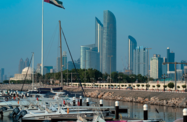Despite falling energy prices, 2015 proved to be another year of healthy economic growth in Abu Dhabi, with both the non-oil and energy sectors targeted for further investment.
In particular, the year brought evidence of the increasingly important role earmarked for research and development (R&D) as a growth driver, with 2015 officially designated as the “Year of Innovation” in the UAE. This formed part of a broader push to advance diversification efforts, with the GDP contribution of the non-hydrocarbons sector surpassing the 50% mark in 2014.
Tourism arrivals also saw strong growth during the year, with further increases expected in the next two years, as attractions like Louvre Abu Dhabi come on-line.
Growth measures
Official forecasts put Abu Dhabi’s year-end growth at around 5.2%, though estimates released in early December suggest the pace of GDP growth could slow to around 4% in 2016 on the back of weaker energy receipts.
Growth is likely to remain relatively steady in the coming years, in line with figures from the Abu Dhabi Department of Economic Development, averaging around 4.2% per annum through to 2019.
Inflation, meanwhile, stood at 3.5% year-on-year (y-o-y) in November, down from 6.1% in September, according to Statistics Centre - Abu Dhabi. The decline, which was generated in part by lower transport costs and a reduction in food and beverage prices, was expected to continue through to the end of the year.
Non-energy upside
Key non-energy sectors, including tourism and transport, had a strong year, with visitor arrivals up 17% y-o-y in the first six months of 2015 at 1.98m. While domestic tourism accounted for 44% of the total, international leisure tourism is also on the rise, particularly from India and China.
The tourism sector is set to receive a further boost when the Midfield Terminal Building (MTB) opens in 2017. With initial passenger handling capacity of 30m per year, scalable up to 45m, the MTB will rank as the largest building in the emirate.
In the transport sector, meanwhile, container traffic at Abu Dhabi’s ports increased by 41% y-o-y in the first seven months of the year to more than 772,000 twenty-foot equivalent units (TEUs), despite a broader decline in global traffic.
Capacity at Khalifa Port is set to receive a further boost in 2016 and 2017, with the planned delivery of new equipment to help keep pace with rising demand. According to local media reports, 2016 is forecast to see a further 10% increase in cargo handling to 1.62m TEUs.
Banking sound, but slowing
Abu Dhabi’s banking system also remained solid throughout 2015, buoyed by resilient capital and liquidity buffers that protected the emirate from external shocks and vulnerabilities, ratings agency Moody’s said in December. However, the agency warned of an expected easing in credit growth, from 9% in 2014 to between 3% and 5% per annum in 2015 and 2016.
Sector forecasts for 2016 were more mixed. A report issued in December by Kuwait’s Global Investment House concluded that credit growth in the broader UAE could pick up in the new year, fuelled by increased spending on infrastructure. Meanwhile, other analysts pointed to a possible scaling back of public expenditure, which could reduce liquidity in the banking sector.
Borrowing costs in the UAE have already edged up, with three-month money market rates hitting their highest level in five years in November, according to media reports.
Market highs & lows
Continued development of the Abu Dhabi Securities Exchange (ADX) could provide alternative financing for companies, with the exchange seen as more attractive in the wake of the US interest rate hike, thanks to the dirham’s peg to the US dollar.
In 2015 the ADX announced a series of measures aimed at increasing the number of traded companies, with a particular focus on encouraging smaller firms to list as a means of financing expansion. The exchange also mapped out plans to launch a derivatives market as early as 2016.
Despite endeavours to broaden its base and increase liquidity, the ADX was expected to finish the year in negative territory. The main index was down by nearly 2% at year-end at around 4300 points, off from a peak of 4900 in late July.
Much of the late-year decline was driven by concerns over the impact of a further drop in energy prices, with Brent crude slipping below $35 per barrel in early January.
Maximising production
Bucking the global trend of declining oil and gas capital expenditure, in April Abu Dhabi National Oil Company (ADNOC) announced plans to invest $25bn in offshore oil projects over the next five years, with the aim of increasing production to 3.5m barrels per day (bpd) by 2019, up from 3m bpd in 2015.
Higher spending on R&D and advanced technology to enhance the output of new and existing deposits will also support Abu Dhabi’s efforts to maintain its position as a top producer.
The Petroleum Institute, an arm of ADNOC, plans to open a new research institute in early 2016, with a focus on enhanced oil recovery techniques — a process seen as key in extending the life of Abu Dhabi’s fields. Additionally, the centre will support activities in engineering and geophysics, while also promoting other downstream activities expected to help broaden the base of the economy in the coming years.
Oxford Business Group is now on Instagram. Follow us here for news and stunning imagery from the more than 30 markets we cover.

